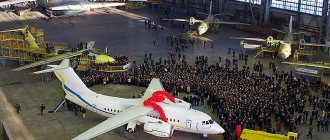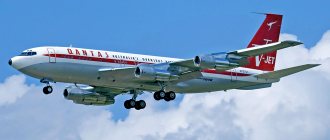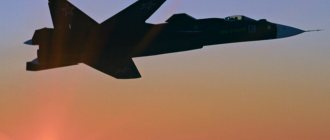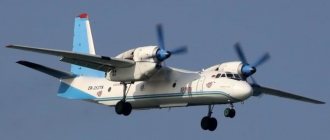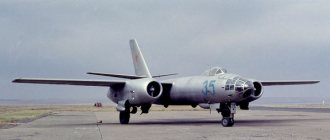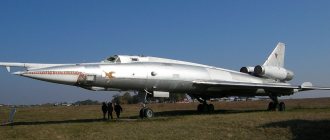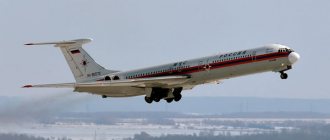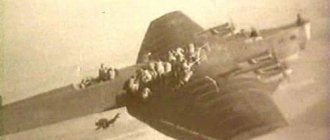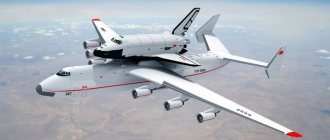| IL-86 | |
| Il-86 of Aeroflot airlines | |
| Type | passenger plane |
| Developer | OKB Ilyushin |
| Manufacturer | VASO |
| First flight | December 22, 1976[1] |
| Start of operation | December 26, 1980 |
| End of operation | 2011 |
| Status | withdrawn from commercial operation, some copies are operated by government agencies |
| Operators | Aeroflot, Air Force of the Russian Federation, Air Force of the USSR, Russian Sky Airlines[d], Krasnoyarsk Airlines, Pulkovo, Transeuropean Airlines[d], Vnukovo Airlines, Armavia, Armenian Airlines[d], China Xinjiang Airlines[d] , Air Kazakhstan, Kazakhstan Airlines[d] and Uzbekistan Airways |
| Years of production | 1976 — 1997 |
| Units produced | 106[2] |
| Options | IL-80 |
| Images on Wikimedia Commons | |
Il-86
is a four-engine wide-body passenger aircraft for medium-haul airlines, designed by the Ilyushin Design Bureau. According to NATO classification - “Camber” (“Curved”, “Convex”). The first and most popular Soviet passenger wide-body aircraft. It was mass-produced in 1980-1997 at the aviation plant of the Voronezh Joint-Stock Aircraft Manufacturing Company in Voronezh. A total of 106 aircraft were produced.
Short description
The first IL-86 took off ten years later than its American counterpart, the Boeing 747 modification. This delay is caused not only by the weak development of the Soviet aircraft industry, but also by economic preconditions associated with the financial crisis.
At that time, there were no passenger airliners capable of carrying more than 300 passengers in the crumbling Soviet Union. Citizens of the USSR flew abroad very rarely; the entire procedure was accompanied by numerous checks and surveys. Nevertheless, work on creating an airbus of that time began already in the seventies of the last century.
Production
The IL-86 was mass-produced from 1979 to 1997 at the Voronezh Aviation Plant (VASO).
A total of 106 aircraft of all modifications were built (102 Il-86 and 4 Il-80 for the needs of the USSR Ministry of Defense)[2]. Three aircraft were exported to China. The four aircraft were built as a variant of the Il-87 (Il-80) air command post to control the armed forces in the event of a nuclear conflict.
Prerequisites
Let's start with the fact that for American air carriers in the early 70s, a wide-body aircraft was vital. The first version of such a liner was presented. Aeroflot was quite capable of meeting the country's needs with the TU-134, IL-62, IL-18, TU-154, YAK-40 models.
These aircraft were distinguished by their reliability, maneuverability and other characteristics. IL-86 made its first flight during the Olympics held in Moscow. The main purpose of the unit is to ensure the transportation of passengers from Domodedovo and Sheremetyevo airports.
Links
Stormtroopers IL-2 ·
IL-8
·
IL-10
·
IL-16
·
IL-20 (1948)
·
IL-40
·
IL-102Torpedo bombers and anti-submarine aircraft DB-3TP ·
IL-6
·
IL-38Transport aircraft or dual purpose IL-32 ·
Il-76
·
Il-112
·
Il-214Special aircraft based on transport A-50 ¹
A-60
¹
Il-78
976
SKIP
¹
A-100
¹Passenger aircraft IL-12 ·
Il-14
·
Il-18 (1946)
·
Il-18
·
Il-62
·
Il-86
·
Il-96
·
Il-103
·
Il-114Special aircraft based on passenger IL-20 ·
Il-24N
·
Il-80Current projects Il-112V ·
Il-214
² ·
Il-76MD-90A (Il-476)
·
PTS "Ermak"Unrealized / experimental IL-26 ·
Il-36
·
Il-42
·
Il-52
·
Il-56
·
Il-64
·
Il-66
·
Il-66
·
Il-70
·
Il-72
·
Il-72
·
Il-74
·
Il-84
·
Il -90
·
Il-106
·
Il-108
·
Il-118
·
Il-196Notes: italics Promising, experimental, or samples that have not gone into mass production are highlighted;
in bold
; ¹ together with Beriev Design Bureau; ² together with NPK Irkut
Development and testing
The IL-86 aircraft, the photo of which is presented above, became the first domestic passenger airliner with a wide fuselage. The requirements for the unit stipulated many nuances, among which the cabin capacity for at least 250 passengers, as well as the possibility of landing it on available runways, was of particular importance.
In October 1967, it was decided to create an aircraft with an extended fuselage by 6800 mm. Development of the 350-seat aircraft began at the Ilyushin design bureau.
To accommodate such a number of personnel, it was necessary to increase the number of seats in each row, without neglecting comfort conditions. As a result, the OKB developed a two-deck version and a single-level analogue. The fuselage was equipped with a pair of separate cabins. This proposal did not find support from the customer.
Incidents
Of the 106 aircraft built, as of July 8, 2008, four were lost[12].
| date | Board number | Location of the accident | Victims | Short description |
| 08.03.1994 | 86119 | Delhi | 8/n. d. | A falling Boeing 737 hit a standing plane, and the Il-86 caught fire. Airport employees serving the plane were killed |
| 06.1998 | 86080 | Sheremetyevo | 0/n. d. | Rough landing. The airliner was decommissioned on July 2, 1998 |
| 21.09.2001 | 86074 | Dubai | 0/322 | Landing with the landing gear not extended due to gross errors by the crew; when touching the runway, the airliner caught fire. |
| 28.07.2002 | 86060 | Sheremetyevo | 14/16 | During takeoff, a stall occurred due to reaching a supercritical angle of attack. The contact of the stabilizer control switch is broken. The stabilizer deviated to a maximum angle of 12 degrees . According to the official version, the crew made an error in controlling the stabilizer. The stabilizer was set incorrectly from the beginning and without rearranging the rudders there was not enough effort to parry it, which led to disaster. Switch failure is not fatal and can be countered in several ways, but the crew did not take appropriate measures. |
On March 17, 1991, on board an Il-86 over the Urals, a terrorist threw two bombs in the cabin. The plane's cabin was heavily smoked. The cabin windows are covered with a layer of soot. Only after the soot was cleared away was it possible to see the landing strip. Successful landing. The second pilot was Honored Pilot of the Russian Federation Yuri Sytnik[13].
Modernization
In February 1970, specialists from the Ilyushin design bureau received the task of developing an aircraft capable of carrying at least 350 passengers. On February 2, 1970, the OKB was given a specific task to design a wide-body passenger aircraft. Just two years later, active development of a model focused on transporting people according to the “luggage with you” principle began.
The designers had a difficult task - to make a plane with the correct geometry and seating arrangement. This indicator was influenced not only by aerodynamic parameters, but also by safety, commercial component, crew comfort, as well as loading and unloading of luggage. As a result, the developers of the IL-86 model settled on a version with a round fuselage section and an arrangement of seats on the upper deck according to the 3/3/3 formula. This solution made it possible to place nine seats in one row, providing two aisles. Among the technical innovations, one can note the use of wing mechanization from fender liners with three slots.
Notes
- [www.ilyushin.org/en/about/history/first-flights/ Official website of JSC Aviation Complex named after. S.V. Ilyushin." Dates of first flights.]
- ↑ 1234
[russianplanes.net/planelist/Ilushin/Il-86 Register of aircraft of the Ilyushin Il-86 type]. russianplanes.net. Retrieved March 27, 2013. [www.webcitation.org/6FcBp2VQv Archived from the original on April 4, 2013]. - Talikov N.D.
Three quarters of a century of “Ilyushin’s” sky... - M.: Bulletin of the Air Fleet, 2008. - P. 190 - Talikov N.D.
Three quarters of a century of “Ilyushin’s” sky... - M.: Bulletin of the Air Fleet, 2008. - P. 198 - Talikov N.D.
Three quarters of a century of “Ilyushin’s” sky... - M.: Bulletin of the Air Fleet, 2008. - P. 212 - [www.ilyushin.org/history/dates.html Official website of JSC Aviation Complex named after. S.V. Ilyushin.” Dates of first flights.]
- www.aviadocs.net/MAK/AC/IL_86/N10_86_D0_D31.pdf
- Talikov N.D.
Three quarters of a century of “Ilyushinsky” sky... - M.: Bulletin of the Air Fleet, 2008. - P. 240 - [civilavia.info/documents/c8eb_86.html Il-86. History of the series.]
- [www.fontanka.ru/2013/02/27/227 The plane behind the Ring Road: its history and future - City - News of St. Petersburg - Fontanka.Ru]
- [www.vaso.ru/?menu=planes_p09 Il-86]. Voronezh Joint-Stock Aircraft Manufacturing Company. Retrieved January 29, 2013. [www.webcitation.org/6E7EbsGxx Archived from the original on February 2, 2013].
- [aviation-safety.net/database/dblist.php?field=typecode&var=315%&cat=%1&sorteer=datekey&page=1 Aviation Safety Network]
- [www.m24.ru/articles/46762 Miracle on the Neva: how they managed to land a passenger liner on the river]. m24.ru: online publication (June 9, 2014). Retrieved March 21, 2020.
Characteristics of IL-86
The lower deck of the aircraft was equipped with special racks, which were intended for luggage and other cargo. Before entering this part of the ship, passengers had to go through three hatches, leaving their burdens, after which they were directed to the passenger part on the second level (along several single-flight staircases).
The peculiarity of the IL-86 aircraft is the speed of movement of passengers, who spent less time boarding and checking in luggage. This option is mainly due to the procedure for registering cargo transportation, which does not require lengthy sorting and loading of things on board. This also includes the absence of downtime at the conveyor belt for several minutes.
Tests
In December 1976, the first flight of a prototype IL-86 aircraft took place, the photo of which is shown below. This action was carried out from the central airfield named after. Frunze. The flight director was E. Kuznetsov, who performed a technical flight from Moscow to Sochi in 1978. During the same period, flights were carried out in the direction of Leningrad, Rostov-on-Don, Simferopol and Mineralnye Vody.
As noted in the official data of the Ilyushin design bureau, the aircraft in question managed to visit Novosibirsk (the official landing date is February 1980). In December of the same year, the aircraft received an airworthiness certificate. After this, the first regular flight was made on the route Moscow - Tashkent.
Salon IL-86
After the start of official use of the aircraft in question, this vessel set 17 officially confirmed world records. Among them:
- Flight along a closed route for one and two thousand kilometers.
- Lifting various types of loads at speeds over 970 kilometers per hour.
- The highest reliability indicator among civil aviation aircraft at that time.
The wide-body aircraft was designed for operation in medium-length periods. At the time of the creation of the vessel, it was equipped with modern equipment, which ensured the reliability and maneuverability of the vehicle, along with a high safety indicator. For the creation of such a unit, the creators were awarded the Lenin Prize and a number of other state awards.
About one aviation accident with Il-86
Il-86 incident. The Tashkent-Moscow flight crash-landed in Aktobe. After takeoff, the flaps were not fully retracted due to a mechanism malfunction. As a result, at an altitude of about 10 thousand meters, one section of the flaps came off. The plane was landed without the use of wing mechanization. No people or equipment were injured, only the wheels were almost completely burned during braking. The plane stayed in Aktyubinsk for 5 days, and after recovery it flew under its own power to Moscow. This was in August 1986 or 1987.
Il-86 USSR-86007. Aktyubinsk Photo: Mulin Sergey
Newspaper report
TASS transmitted the Decree of the Presidium of the Supreme Soviet of the USSR: “For high flying skill and courage shown in the performance of official duties, award the Order of the Red Banner of Labor to: Ivan Petrovich PANKOV, the ship’s commander, and Vladimir Semenovich SHLEENKOV, the senior on-board engineer; Order of the Badge of Honor: Leonid Vladimirovich BUGAEV - co-pilot, Sergei Grigorievich KOKORU - navigator and Vladimir Stepanovich TARASOV - on-board engineer." Our special correspondent talks about this flight.
The HUGE plane slowed down and finally became quiet, like a guilty preschooler in a corner. From the airport building, from the steps of fire trucks, people, pilots, passengers, and airfield staff looked at him: at the Aktobe airport, the IL-86 looked unusual.
The senior flight engineer ran down the front ramp and looked at the wheels of the landing gear - seven of them were lowered and could not withstand the emergency braking. The senior flight engineer looked at the wheels and, purely like a driver, suddenly kicked one at a time with his boot. The commander came out. The tension of these last thirty-eight minutes did not let go. He smiled at the passengers who thanked him, but he himself fully realized what had happened and what could have happened only an hour after landing, already at the hotel... - And what time did it all end, Ivan Petrovich? - I asked the commander. We also talked to his native Vnukov; there were diagrams on the table, according to which navigator Sergei Kokora later demonstrated how they approached the landing. “At seven fifty...” answered the commander. And he clarified: “No, at seven fifty-three.” And I wrote down the numbers and the notepad. It's good to deal with accurate people! Thank you, Ivan Petrovich.
...Everything then went as usual, “Our plane is flying Tashkent - Moscow... The flight will take place at altitude... Fasten your seat belts... You will be offered a hot breakfast... Travel time...” “And what time did it all start?” I asked the commander. “At seven fifteen,” answered the commander. By seven fifteen, the IL had long since gained altitude and broke out of the cloud cover, when suddenly the plane began to shake with a harsh, unpleasant tremor. Violent trembling. “The co-pilot and I couldn’t hold the controls in our hands,” said the commander. “It shook so much that the instruments were no longer visible - the arrows were darting,” said the senior flight engineer. “Imagine, you’re in the cold in your clothes - and into an ice hole.” And then you’ll be hit with a washboard,” the navigator added expression. The shaking was unlike anything: “Well, on the IL-62, if you exceed the speed, shaking occurs, but, firstly, not like that, and secondly, our speed was not the same, and not on the sixty-second we...” “Volodya,” the commander ordered the senior flight engineer, the most free member of the crew at that moment, “run into the fuselage, see what’s there...” Shleenkov went. And as soon as I stepped into the cabin, the plane jerked and the shaking stopped (the navigator recorded it 75 seconds after it started). The body still vibrated, but not like that, far from it... The engines, Shleenkov looked, are working normally, what's going on?.. And then a passenger from the back rows: “Look, here you have...” - and points out the window.
Officially speaking, part of the aircraft's wing mechanization was damaged. A situation has arisen that no Aeroflot crew has ever experienced. And the decision had to be made instantly. The commander made the decision, as experts later recognized, as the only correct one: the IL-86 began to descend. This was another critical moment of the flight: how would the remaining flap sections behave? “Get ready, the shaking will start again, we’ll land in the field,” said the commander, “Volodya, run into the fuselage...” Shleenkov went into the cabin again. The flight attendant was serving breakfast. All the passengers were calm - only one, the one at the rear window, joked: “Our plane is falling apart, and you - breakfast?..” “The plane is not falling apart,” Shleenkov answered, “and that’s why breakfast...” There was no more shaking, Shleenkov returned to the cockpit. “We’ll land in Aktyubinsk,” the commander decided, and the flight attendant picked up the microphone: “Citizens, passengers! For technical reasons, our plane will land at the city airport...” Aktyubinsk, strictly speaking, is not intended for landing airbuses. Wrong lane, wrong concrete. But there was no choice - there were about one hundred and seventy kilometers left to Aktobe... The Earth helped in any way it could: it “cleared” the corridor, kept in touch... Advice, recommendations? They, in Aktyubinsk, do not operate this car, it will take so much time to contact Moscow and explain what happened (when it is not completely clear to them) ... In general, they had to rely mainly on their own strength, and above all on the youngest in crew of navigator Sergei Kokoru. It was he who had to urgently rebuild the entire landing complex at Aktyubinsk.
“You know,” the commander told me, “in such emergency situations it is necessary to make allowances for a certain, let’s say, coefficient of extremity.” Roughly speaking, we need to come to our senses. And here Seryozha didn’t even have time to lose his temper... Kokora made all the calculations correctly and as quickly as required. The plane began to land. The first time they “didn’t fit in.” But the second time the chassis touched the stripes almost on the very first slab. The commander took a risk here, too, but this risk was less evil: usually, even with fully extended mechanization, the IL-86 lands at a speed of 260 kilometers per hour, but here the speed was already 85 kilometers higher... The Airbus landed almost like a fighter (by the way , by education Pankov was a fighter - he graduated from the Yeisk School). But will the lane be enough at this speed?.. The commander turned on the emergency brake. The huge plane slowed down and finally became quiet, like a guilty preschooler in a corner... By 16.00 the reserve IL arrived and picked up the passengers. Not one of the 279 even tried to return the tickets. The vast majority of them did not notice anything until they landed and entered the field. And an hour and a half after the events, general designer Novozhilov arrived from Moscow. He examined the plane, shook hands with the commander: “Thank you for landing!” Then a special commission will confirm that it was done flawlessly.
P. GUTIONTOV.
And here is the passenger's testimony:
My parents and I were on that flight from Tashkent. I can say without any feigned pathos: they were preparing to die. The flight attendants cried, collected the distributed food (350 people, summer, vacations, and not everyone had eaten by that time), and then just sat down in their seats and sat white as a sheet and sobbed. My parents took me by the hands, my mother later told me that she and my dad were saying goodbye... He flew for quite a long time at a low altitude, they saw the ground, maybe he was just dumping fuel. For some reason I remember the sound, as if a sea vessel were holding together in a storm. What’s most interesting is that immediately upon arrival (we went out ourselves), rumors spread among the passengers about an engine fire. There, where BI was running, there were drunken warriors sitting, they were the only ones who were laughing. Then from Aktyubinsk, a few hours later, two Tu-154s sent us to the DMD, by the way, and we were supposed to fly there on an Il-86, I also remember the heavy rain that day, the guy kept wrapping me in a windbreaker
Relatives standing in the rain were told the same thing: “Departed on schedule.” Then they reported that they had landed in Aktyubinsk and nothing more. Mom told me that when they walked from the arrival hall in Moscow, people whispered: “The dead are coming,” and people in Aktobe said the same thing. That is, people somehow knew about us in advance?! My father (he was good with humor, especially with black humor), when they were going down the ramp in Aktyubinsk, noticed fire trucks. Several of them were watering the plane, apparently those that had taken off their shoes, and one car was standing in front of the cockpit. My father told some woman that this car had come to water our bones. Interestingly, we sat down and then taxied for a long time, past some hangars, I remember military aircraft. I hadn’t seen them before, I was little... It turns out I was exactly five years old then, but everything was put on hold, stress. I also remembered a detail, but it’s not clear. Either during the flight it somehow sounded that they might land us in Orenburg, or when people arrived they were wondering where we landed, since the airport was not visible, and the flight attendants were still in a trance, and the pilots probably had no time for it , so that we can pick up something else. We saved the main thing! A low bow to them, Pankov and Bugaev, for the fact that I can sit like this in my fourth decade, already having two children of my own, in front of the monitor and remember my childhood, which did not end suddenly somewhere in a field near Chelkar or Aktobe. PS I would like to look at the journalist Gutiontov, as if he hadn’t noticed anything, yeah... By the way, as I already wrote, they sent for us not IL, but two Carcasses. He contradicts himself in the article. Either his Aktyubinsk is not intended for landing the Il-86 and the crew takes a risk, landing the emergency vehicle the second time on the first slab, because there is no way out, and then, suddenly, of their own free will, the reserve Il arrives from Moscow so calmly . There was no Il there, not the 62nd, much less the 86th. And one more moment here is embellished, obviously in the direction of a happy ending. My father’s friend worked at TAPOiCh as a designer and knew Novozhilov personally. He later said, as they say in the kitchen, that there were long disputes at the Ilyushin design bureau and at first they tried to blame the pilots for everything (for example, for draining fuel and, allegedly, Novozhilov generally said that they almost were supposed to continue the flight to Moscow, maybe this is nonsense, poorly learned by me in my childhood), but, apparently, they figured it out later and “reported the details” in the newspaper. I was interested in aviation then, my favorite author was M. Vodopyanov, my mother read him to me every day, so I already paid attention to aviation details as best I could. But he distinguished the types of aircraft well. We flew a lot with our parents.
https://aviaforum.ru/threads/il-86-sssr-86007-aktjubinsk.1940…
Peculiarities
With the length of the IL-86 aircraft being almost 60 meters, it had many advantages between domestic and foreign counterparts. In fact, the aircraft was a low-wing airbus with four turbine engines. It is equipped with a single-fin tail and swept wings.
The NK-86 power units were specially created for this aircraft, which are modernized engines used on the IL-62 and TU-154. Engine thrust - 13,000 kgf. It was these “engines” that became the main reason for the withdrawal of the aircraft from serial operation. The fact is that the NK-86 had a high noise level and fuel consumption. It got to the point that people began to joke about these power units, claiming that they launch the plane with a sluggish takeoff and that this is possible only thanks to the curvature of the Planet. In addition, the dimensions of the specified engine, taking into account the airframe and landing gear, made it impossible to calculate the maintainability of the aircraft and its effective operation at high ambient temperatures. When the aircraft took off, temperature sensors often triggered, which led to complete or partial deactivation of the engines.
Flight performance
Data source: VASO website[11]
Specifications
- Crew: 3-4 people.
- Passenger capacity:
- 3-class layout: 314
- 2-class layout: 234
- Economy: 350
- Load capacity: 42 t
- Length: 59.94 m
- Wingspan: 48.06m
- Height: 15.81 m
- Wing area: 320 m2
- Curb weight: 111.5 t
- Maximum take-off weight: 215 t
- Fuel mass in internal tanks: 88000 kg
- Powerplant: 4 × NK-86 turbofan engines
- Thrust: 4 × 13,000 kgf
- Auxiliary power unit: 1 × VSU-10 gas turbine engine
Flight characteristics
- Cruising speed: 950 km/h
- Practical range: 3800 km (maximum take-off weight)
- Service ceiling: 12,000 m
Interesting Facts
For the sake of fairness, it is worth noting that the interior of the IL-86, the photo of which is presented below, had excellent sound insulation. Despite the noise of the power plants, passengers did not experience any particular discomfort during the flight. However, the sound level did not allow it to fit into acceptable international standards for regular flights in the civil aviation line.
This has created a problem for flights to countries abroad. By and large, the viability of one of the first Soviet airbuses was short-lived. The mass withdrawal of these aircraft began already in 2001. This was largely due to their impracticality and increased noise. The last flights for IL-86 were flights from Moscow to Sochi and Simferopol. She worked in this direction until October 2010.
In the 80s of the last century, research was carried out on IL-86 series aircraft in the USSR. Subsequently, they planned to install engines of the Rolls-Royce RB211-22B turbofan engine type (manufactured in Great Britain, traction power - 19,000 kgf). As a result, the aircraft was supposed to have an extended fuselage and the ability to transport at least 450 passengers over a distance of up to four thousand kilometers.
It was on the basis of the IL-86 that a long-range analogue under the symbol 96 was developed and created. Unfortunately, both modifications never became serial airliners, due to practical considerations. This niche was occupied by Airbus brand models (Airbus A310), which served for about ten or fifteen years, as well as Boeing configurations Boeing 747, Boeing 767.
Modifications
| Model name | Brief characteristics, differences. |
| IL-86 | Basic option. One copy is made in a special version to serve the President of the Russian Federation. |
| Il-86V | A project to transport 450 passengers over a distance of 3600-4000 km. |
| Il-86D | A project of a modified Il-86, on the basis of which the Il-96 aircraft was developed. |
| Il-80/87 (NATO codification: Maxdome ) | Air command post. It is distinguished from conventional Il-86 by the absence of windows, an in-flight refueling system and an additional hardware compartment (“hump”) in the forward part of the fuselage. 4 copies built. |
Bottom line
The history of the Soviet Airbus was not crowned with success, like its immediate successor, the IL-96. The total number of units built with extended fuselages was only 27 units. Only 11 machines are involved in active operation, which continues to this day. Some examples are part of a special Russian flight detachment; another 3 are in service in Cuba. The developers note that the four-engine long-haul aircraft under consideration have not found proper application due to high fuel consumption and noise, as well as low comfort for passengers.
